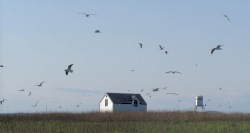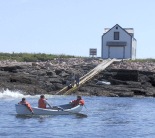This 10-acre island lies 2.5 miles south of Petit Manan Point in the Town of Steuben, Washington County. It was acquired in 1974 by transfer from the U.S. Coast Guard. The Coast Guard continues to maintain the 119’ lighthouse tower and navigational aids, and the Service maintains several historical structures on the island. Petit Manan has long been considered one of the most important islands in the Gulf of Maine for colonial nesting seabirds.
Botanical inventories, including those for rare plants, were conducted in 1995, 2001, and 2002 (Widrig 1996 and Mittelhauser 2002). Vegetation on the north and east side of the island includes a variety of grasses, Angelica, raspberry, asters, meadowrue, blueberry, and beachpea. The southwestern and central areas of the island are dominated by a dense stand of raspberry which is rapidly expanding each year. Calamagrostis occupies a large portion of the western half of the island. The invasive species dodder established a strong foothold on the northern end of the island in 2000. Extensive vegetation management occurs, utilizing a variety of techniques such as burning, herbicide, and mechanical treatment to improve nesting seabird habitat. Annual monitoring of this vegetation and its response to treatment dictates what to do in forthcoming years.


